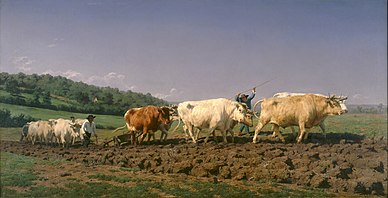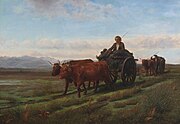Ploughing in the Nivernais
| Ploughing in the Nivernais | |
|---|---|
 |
|
| Artist | Rosa Bonheur |
| Year | 1849 |
| Medium | Oil on canvas |
| Dimensions | 133 cm × 260 cm (52 in × 100 in) |
| Location | Musée d'Orsay, Paris |
 |
|
|
|
Ploughing in the Nivernais (French: Labourage nivernais), also known as Oxen ploughing in Nevers, is a painting by French artist Rosa Bonheur. It depicts two teams of oxen ploughing the land, and expresses the deep commitment to the land that was typical of the French Third Republic; it may have been inspired by the opening scene of George Sand's 1846 novel La Mare au Diable. Commissioned by the government and winner of a First Medal at the Salon in 1849, today it is held in the Musée d'Orsay in Paris.
The Nivernais, the area around Nevers, was known for its Charolais cattle, which was to play an important role in the agricultural revolution that took place in the area in the nineteenth century. Rosa Bonheur gained a reputation painting animals, and Ploughing in the Nivernais features twelve Charolais oxen, in two groups of six. On a sunny autumn day they plough the land; this is the sombrage, the first stage of soil preparation in the fall, which opens up the soil to aeration during the winter. Humans play a minor role in the painting—the farmer is almost completely hidden behind his animals. The freshly-ploughed land is prominent in the foreground, while the landscape behind is basking in sunlight. The painting's clarity and light resembles that of the Dutch paintings (esp. by Paulus Potter) which Bonheur had studied as part of her education.
According to Albert Boime, the painting should be seen as a glorification of peasant life and its ancient traditions; he places it in the context of the revolutionary year 1848, when cities were the scene of chaos and strife. It is one of the paintings that expresses the Third Republic's "deep cultural attachment to the home soil", according to Claire Keith, who found this in the work of George Sand as well.
...
Wikipedia
